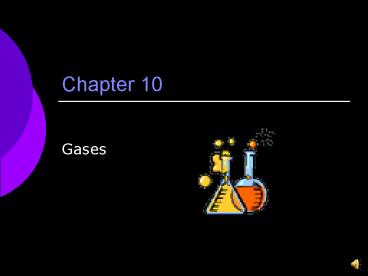Gases - PowerPoint PPT Presentation
1 / 33
Title:
Gases
Description:
When two gases are present, the total pressure is the sum of the partial ... Example. What volume is occupied by 0.250mol of carbon dioxide at 25.0 ... – PowerPoint PPT presentation
Number of Views:46
Avg rating:3.0/5.0
Title: Gases
1
Chapter 10
- Gases
2
What is a gas?
- Phase of matter that has no definite shape or
volume. - Conforms to the shape and volume of container.
http//www.harcourtschool.com/activity/states_of_m
atter/
3
Kinetic Molecular Theory
- A simple model applied to explain the properties
of an ideal gas. - The particles are so small compared with the
distances between them that the volume of the
individual particles can be assumed to be
negligible.
4
- Particles are in constant motion. The collisions
of the particles with the walls of the container
are the cause of the pressure exerted by the gas.
5
- The particles are assumed to exert no forces on
each other they are assumed neither to attract
nor repel one another.
6
- The average kinetic energy of a collection of gas
particles is assumed to be directly proportional
to the Kelvin temperature of the gas. - Real Gases do not conform to these postulates.
- Have finite volumes and do exert forces on one
another.
7
Measureable Properties
8
Pressure
- Force applied uniformly over a surface.
- Measured as force per unit area.
- Measured using many units
- SI unit Newtons/m2
- Standard Pressure1.00 atmospheres
1.00 atm 760.0 mm Hg 760.0 torr 101.325 kPa
101,325 Pa
9
(No Transcript)
10
Temperature
- Measure of the kinetic energy of the molecules
that make up a substance. - Use the Kelvin Scale
- K 273.15 C
- Thermodynamic temperature scale
- Defines absolute zero
- 0 K-273.15C
- Temperature at which all molecular movement stops
11
Conversions
12
Standard Temperature Pressure
- STP
- Standard Temperature 0.00C273.15K
- Standard Pressure 1.00atm
13
Gas Laws
14
Boyles Law
- Robert Boyle, Irish chemist developed law in mid
1600s - Pressure and volume are inversely related when
temperature is held constant
V ? 1/P
15
Illustration of Boyles law.
P1V1P2V2
16
As Pressure Increases, the Volume of SO2 Decreases
0.57L
17
Charless Law
- Volume of a gas at constant pressure increase
linearly with temperature. - Volume is directly proportional to temperature
- V ? T
18
(No Transcript)
19
(No Transcript)
20
Avogadros Law
- At constant temperature and pressure, the volume
of a gas is directly proportional to the number
of moles of gas. - V ? n
21
The relationship between volume V and number of
moles n. As the number of moles is increased from
1 to 2 (a to b), the volume doubles.
22
Gay-Lussacs Law
- The pressure of a fixed amount of gas at fixed
volume is directly proportional to its
temperature in kelvins. - P ? T
23
Combined Gas
- Evaluates in temperature, pressure and volume.
24
Daltons Law of Partial Pressures
- mixture of ideal gases, each gas has a partial
pressure which is the pressure which the gas
would have if it alone occupied the volume. - The total pressure is equal to the sum of partial
pressures.
25
When two gases are present, the total pressure is
the sum of the partial pressures of the gases.
26
Collecting Gas Over Water
- Water molecules are constantly escaping the
liquid phase to become vapor. - Extent is dependent on temperature
- The total pressure observed is equal to the sum
of the individual gases and the vapor pressure of
water.
27
Ideal Gas Law
- Gases behave ideally at pressure at or lower than
1.00atm and temperature of 0.00C. - Ideal Gas Law allows us to assume ideal behavior
for all gases.
28
PVnRT
- PPressure
- VVolume in Liters
- nnumber of moles
- RUniversal Gas Constant
- 0.08206 L atm/mol K
- 62.4 L mmHg/mol K
- 8.314 L kPa/ mol K
- TTemperature in Kelvin
29
Example
- What volume is occupied by 0.250mol of carbon
dioxide at 25.0C and 371 torr?
30
Example
- Thermal decomposition of KClO3 produces oxygen.
The gas is collected over water at 22C with an
observed pressure of 754 torr and a volume of
0.650L. Calculate the partial pressure of oxygen
the number of moles present. The vapor pressure
of water at 22C is 21 torr.
31
The Production of Oxygen by Thermal Decomposition
of KClO3
32
(No Transcript)
33
(No Transcript)































